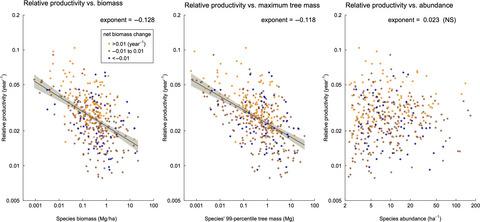Our official English website, www.x-mol.net, welcomes your
feedback! (Note: you will need to create a separate account there.)
Trade‐off between standing biomass and productivity in species‐rich tropical forest: Evidence, explanations and implications
Journal of Ecology ( IF 5.3 ) Pub Date : 2020-08-07 , DOI: 10.1111/1365-2745.13485 Takashi S. Kohyama 1 , Matthew D. Potts 2 , Tetsuo I. Kohyama 1 , Kaoru Niiyama 3 , Tze Leong Yao 4 , Stuart J. Davies 5 , Douglas Sheil 6
中文翻译:

物种丰富的热带森林中固定生物量与生产力之间的权衡:证据,解释和启示
更新日期:2020-08-07
Journal of Ecology ( IF 5.3 ) Pub Date : 2020-08-07 , DOI: 10.1111/1365-2745.13485 Takashi S. Kohyama 1 , Matthew D. Potts 2 , Tetsuo I. Kohyama 1 , Kaoru Niiyama 3 , Tze Leong Yao 4 , Stuart J. Davies 5 , Douglas Sheil 6
Affiliation

|
- Despite its broad implications for community structure and dynamics, we lack a clear understanding of how forest productivity is partitioned among tree species. As leaf mass per unit of standing biomass declines with tree size, species achieving larger stature should show lower relative productivity as compared to smaller stature species. However, many observations indicate large‐stature species grow faster than small‐stature species. In this study, we address this apparent paradox, and clarify interspecific trade‐offs between turnover rates and maximum size in terms of forest‐level productivity and biomass storage.
- We examined data from the 1990 and 2000 surveys of the Pasoh 50‐ha plot of Malaysian rain forest. In these data, individual stems ≥1 cm stem diameter (dbh) have been identified, marked, measured and mapped. We applied site‐specific equations to estimate tree biomass from dbh. We estimated species‐level productivity and loss rates that are less influenced by census interval‐related effects and biases.
- Among 390 abundant tree species, species with high stand‐level biomass were predominantly those large‐stature species where individuals could achieve large sizes. We found that relative (= per‐species‐biomass) productivity and loss rate, per‐capita recruitment and mortality of species were all negatively correlated to species biomass and maximum size, but not to species abundance.
- Large‐stature species grew faster than small‐stature species at the same tree sizes up to 36 cm dbh. However, the relative growth of large species at their maximum size markedly declined. As a result, tree‐level relative growth at maximum size and species‐level relative productivity decreased with species‐level biomass.
- Performing further analyses using smaller plots in four old‐growth forests in Indonesia and Japan, we observed a similar interspecific negative relationship between relative productivity and biomass. We expect this phenomenon is widespread across species‐rich forests.
- Synthesis. How productivity is partitioned among species determines and reflects forest ecosystem functioning and species coexistence. Many species with low biomass and small maximum stem sizes disproportionally contribute to forest primary productivity, rapid recovery and resilience. In contrast, long‐lived, high‐biomass species contribute disproportionally to ecosystem stability and carbon storage. This complementarity reflects differentiation by adult stature among species.
中文翻译:

物种丰富的热带森林中固定生物量与生产力之间的权衡:证据,解释和启示
- 尽管它对社区结构和动态有广泛的影响,但我们对森林生产力如何在树种之间分配缺乏清晰的了解。随着单位立木量单位面积叶片质量的下降,与较小身材的物种相比,较高身材的物种的相对生产力应较低。但是,许多观察表明,高身材物种的生长速度快于小身材物种。在这项研究中,我们解决了这个明显的悖论,并阐明了森林生产率和生物量存储方面周转率和最大规模之间的种间权衡。
- 我们检查了1990年和2000年马来西亚雨林Pasoh 50公顷土地的调查数据。在这些数据中,已识别,标记,测量和绘制了≥1 cm茎直径(dbh)的单个茎。我们应用了特定地点的方程式,以从dbh估算树木生物量。我们估算了受普查间隔相关影响和偏见影响较小的物种水平的生产力和损失率。
- 在390种丰富的树种中,具有高标准生物量的树种主要是那些个体可以达到大尺寸的大树种。我们发现物种的相对(=每个物种生物量)生产率和损失率,人均募集和死亡率都与物种生物量和最大大小负相关,而与物种丰度却不相关。
- 在不超过36 cm dbh的相同树木大小下,大树种的生长速度比小树种的生长快。但是,大物种在其最大尺寸下的相对生长显着下降。结果,树的相对最大生长和物种的相对生产力随物种水平的生物量而下降。
- 在印度尼西亚和日本的四个旧林中,使用较小的样地进行了进一步的分析,我们观察到相对生产力和生物量之间存在相似的种间负相关关系。我们希望这种现象在物种丰富的森林中普遍存在。
- 综合。生产力如何在物种之间分配,决定并反映了森林生态系统功能和物种共存。许多生物量低,最大茎粗小的物种不成比例地贡献于森林的初级生产力,快速恢复和复原力。相反,长寿命的高生物量物种对生态系统的稳定性和碳储存的贡献过大。这种互补性反映了物种之间成年个体的差异。











































 京公网安备 11010802027423号
京公网安备 11010802027423号